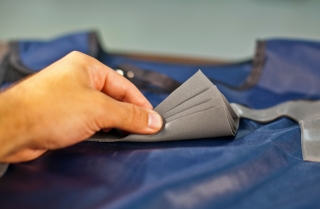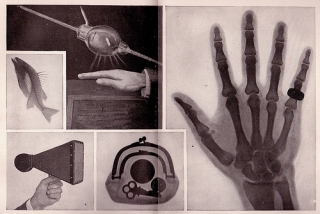Radiation on a Molecular Level
In order to understand radiation protection we would like to briefly educate you on the science of x-rays and why they can be dangerous. Exposure to different energies can affect the human body in various ways. When we are exposed to high levels of energy there can be negative side effects. For instance light rays can blind, sound waves can cause deafness, and heat waves can burn. Similarly, negative side effects may result from exposure to x-ray energy, but why? All matter is made up of atoms. When x-ray energy collides with atoms its effect depends on the strength of the ray and the type of atom encountered. When the interaction causes an atom to lose an electron, an ion, or electrically charged atom is formed. This is the negative effect of radiation exposure because electrically charged atoms are able to break DNA chains. Broken DNA either dies or mutates, which can lead to cancerous cells and birth defects. Due to the fact that alteration of human cells is a possible outcome of radiation exposure, it is imperative to take all proper protective measures against overexposure.
Proper Protection
When referring to radiation protection, a common misunderstanding is the thicker the protective barrier, the better. Yet, this is not true. Yes, thickness plays a role in protection, but the attenuation factor is the main focus. Remember, attenuation is the measurement of absorbed and deflected energy as it passes through a material. (To understand the basics of attenuation read our “What is Attenuation” blog post.) Let’s equate the attenuation theory to a well known item: sunglasses. If you are picking out a pair of sunglasses to protect your eyes from sun damage, your main focus is the tint of the lens, not its thickness. Light is absorbed by dark colors, so the darker the tint of the lens, the less light will pass through to your eyes. Thousands of sunglasses offer the same lens thickness, but the attenuation of light varies most with the lens’ tint. The same concept applies to radiation protection. Just like different lens tints attenuate light rays, different materials attenuate radiation energy.
So what are effective radiation attenuating materials? The truth is that even air attenuates radiation to a degree, because every element attenuates radiation to some extent. Through research and development, it has been concluded that when it comes to radiation attenuation, the most effective elements are the metals. When this fact was discovered, lead was inexpensive and readily available, so lead aprons were put to use. Lead quickly became the industry standard for radiation protection and the term lead equivalency evolved as the measuring tool used to gauge the effectiveness of radiation protection. Lead aprons are comprised of a matrix of lead and PVC (to give the lead durability).
This matrix is then formed into sheets and layered for stronger attenuation and increased flex. So what is the downside? You likely already know it – Protective Apparel that only uses lead as the attenuating metal is HEAVY! Prolonged use can cause back and shoulder injuries for personnel required to wear the aprons day in and day out. The radiation protection industry solved this problem by developing light weight and non lead aprons that protect just as well as the original lead aprons. Lightweight aprons utilize a combination of lead and non lead elements to achieve effective protection levels. Non Lead Aprons use only nonlead elements to achieve effective protection levels. Some of the nonlead elements found in the lightweight and lead free aprons on the market today are tin, bismuth, aluminum, barium, and titanium. These metals are able to attenuate x-rays efficiently while still meeting the original lead equivalency standard. Tin, a lighter weight metal, is combined with lead to create light weight aprons, which reduces stress on shoulders and the lower back. Nonlead aprons not only provide the lightest weight option, due to their lack of lead content, they are considered non-hazardous and can be safely disposed of without fear of environmental impact. The reason there has not been a strong push for adopting these lightweight and nonlead forms of protection is due to a misunderstanding of the attenuation process. Many medical imaging personnel believe lead is the only material that can attenuate radiation effectively. Now that you know that many metals effectively attenuate radiation energy, you can make a better informed decision about the protective apparel you choose. Prior to revealing the dangers of cell mutation, uncontrolled amounts of x-rays were being used for various purposes. In fact, in the 1920s you could walk into a shoe shop and take an x-ray of your foot inside a shoe to find a perfect fit! Shielding ourselves is not the only precaution we can take to protect ourselves from harmful x-ray exposure. Equipment manufacturers have developed x-ray machines with the ability to: control the direction of the radiation beam, limit exposure time, and adjust the power of radiation. The main goal in medical imaging today is to expose patients to the bare minimum amount of radiation and still obtain optimal results. You may hear the term ALARA which stands for As Low As Reasonably Achievable. An example of this would be x-raying a child as compared to an adult. Because a child is smaller there is less mass present for the x-ray to penetrate. So the imaging professional can lower the typical adult power level of the x-ray machine and still obtain optimal results.Anyone working around radiation should ensure they are aware of the levels and frequency with which they are exposed. Understanding exposure and your risk will ultimately allow you to select the proper protection apparel. The attenuation concept is a major focus in radiology and the more we understand about its nature, the further we can advance radiation practices with the correct equipment and protection. If you are ever administering or receiving an x-ray and you are concerned about radiation protection, have no fear if lead is nowhere near. The attenuation concept is still in play when other metals are used. Product manufacturers are meeting standards to protect you from unnecessary radiation damage while preventing shoulder and back injuries!



Leave a Reply